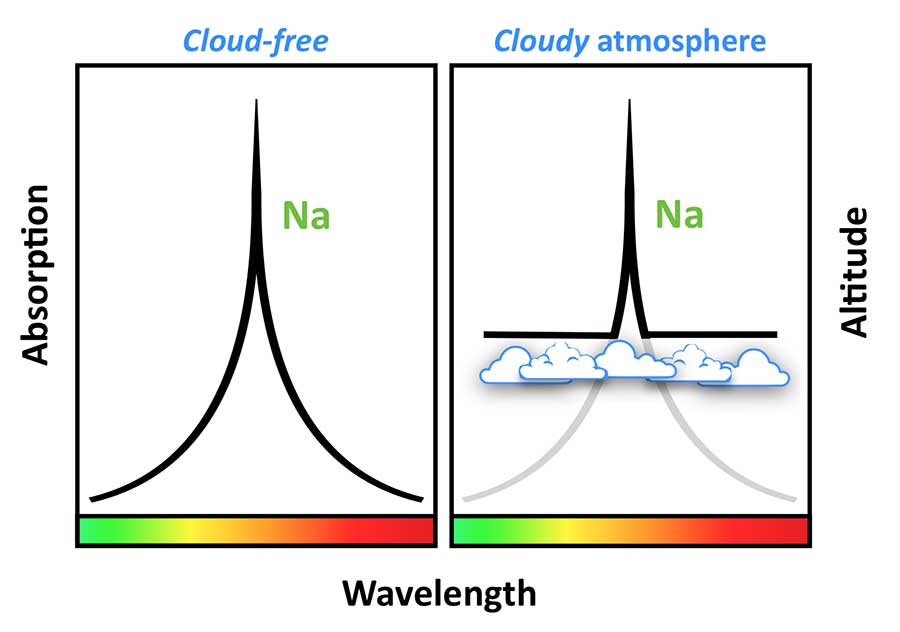Space Scientists See Clear Skies around ‘Hot’ and ‘Salty’ Planet
Sodium signature helps an international team of researchers discover exoplanet's unique cloud-free atmosphere
Published Date
By:
- Cynthia Dillon
Share This:
Article Content
It seems fitting that an astrophysicist from the University of California San Diego, a location associated with sunny days, contributed to an important cosmic breakthrough around the discovery of a cloudless planet.
Exploring space beyond our solar system, UC San Diego Professor of Physics Adam Burgasser collaborated with an international team of astronomers, led by Nikolay Nikolov from the University of Exeter, to discover that the atmosphere of an exoplanet named WASP-96b, a so-called “hot Saturn,” is cloud-free. Their research is now published in the scientific journal Nature in an article titled, “An absolute sodium abundance for a cloud-free ‘hot Saturn’ exoplanet.”
Burgasser, who previously studied clouds in the low temperature atmospheres of stars and brown dwarfs, was a coauthor on the article. He contributed to the interpretation of the observations while he was in residence at the University of Exeter as a Fulbright Scholar this past fall.
“It is always wonderful to be able to apply scientific knowledge from one research area to another,” said Burgasser. “While this is the first time we have seen some of the features detected in this study in an exoplanet atmosphere, they felt very familiar to me from my own work on brown dwarf atmospheres.”
Using Europe’s 8.2m Very Large Telescope (VLT) in Chile, the team studied the atmosphere of WASP-96b when the planet passed in front of its host-star (Figure 1). This enabled the scientists to measure the decrease of starlight caused by the planet and its atmosphere, and thereby determine the planet’s atmospheric composition.

Figure 2 | Sodium fingerprint in an exoplanet spectrum. Shown is the absorption due to sodium at each wavelength. More absorption means that we are looking higher up in the atmosphere, and the vertical axis therefore a measure of altitude in the atmosphere of the planet. An atmosphere free of clouds produces an intact sodium fingerprint with a “tent-like” appearance (left panel). A cloud deck blocks part of the sodium in the atmosphere, partially or completely removing its spectral signature (right panel). Image by N. Nikolov/E. de Mooij
“We’ve been looking at over 20 exoplanet transit spectra,” said Nikolov. “WASP-96b is the only exoplanet that appears to be entirely cloud-free and shows such a clear sodium signature, making the planet a benchmark for characterization.”
Just as fingerprints are unique, atoms and molecules have specific spectral absorption patterns that can be used to detect their presence in celestial objects. The spectrum of WASP-96b shows the complete fingerprint of sodium—the seventh most common element in the universe—which can only be observed in a cloudless exoplanet atmosphere (Figure 2). The observation allowed the team to measure how abundant sodium is in the atmosphere of the planet, finding levels similar to those found in our own Solar System.
It has long been predicted that sodium exists in the atmospheres of hot gas-giant exoplanets and, in a cloud-free atmosphere, its highly broadened line produces a spectral pattern similar in shape to the profile of a camping tent.
“Until now, sodium was revealed either as a very narrow peak or found to be completely missing,” explained Nikolov. “This is because the characteristic ‘tent-shaped’ profile can only be produced deep in the atmosphere of the planet, and for most planets clouds appear to get in the way.”
Clouds and hazes are known to exist in some of the hottest and coldest solar system planets and exoplanets. The presence or absence of clouds and their ability to block light plays an important role in the overall energy budget of planetary atmospheres.
"It is difficult to predict which of these hot atmospheres will have thick clouds,” noted Jonathan Fortney, another study co-author who runs the Other Worlds Laboratory (OWL) at the University of California, Santa Cruz. “By seeing the full range of possible atmospheres, from very cloudy to nearly cloud-free like WASP-96b, we'll gain a better understanding of what these clouds are made of.”
WASP-96b is a typical 1300 ºK (1030 ºC, 1880 ºF) hot gas giant, similar to Saturn in mass and exceeding the size of Jupiter by 20 percent. The planet periodically transits a Sun-like star 980 light years away in the southern constellation Phoenix, halfway between the bright southern jewels of Fomalhaut (α Piscis Austrini) and Achernar (α Eridani).
According to co-author Ernst Ernst de Mooij from Dublin City University, WASP-96b will also provide scientists with a unique opportunity to determine the abundances of other molecules, such as water, carbon monoxide and carbon dioxide, with future observations. The team plans to look for signature of these molecules with the Hubble and James Webb Space Telescopes, as well as telescopes on the ground.
At UC San Diego, we are changemakers. Recognized as one of the top 15 research universities worldwide, our culture of collaboration sparks discoveries that advance society and drive economic impact.
Share This:
You May Also Like
Stay in the Know
Keep up with all the latest from UC San Diego. Subscribe to the newsletter today.



